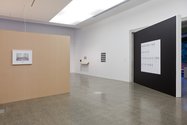John Hurrell – 16 June, 2015
Some of these projects as ‘sound works,' either inevitably lost a lot of their visceral intensity in their recording (like the revved up motorbikes which are a different experience live) or else were initially highly visual (the huge blue tarpaulin and red LEDs of 'Severe Tropical Storm 9301 Irma', 2002) before being transmuted into other more subdued or confined formats.
Titirangi
Billy Apple
Sound Works 1968 - 2015
Curated by Andrew Clifford
24 April - 10 June 2015
In this satellite show to the much larger Christina Barton curated Billy Apple survey at AAG - one of several - thirteen recordings (or scores) were presented as Billy Apple aural (or sonic) works: the terms ‘aural’, ‘sonic’, ‘audio’ or the titular ‘sound’ possibly making a clear distinction in opposition to the more emotional, ‘expressive’ and lyrical anthropological phenomenon, music. These mostly collaborative pieces were presented in one ground level gallery (containing an enclosed smaller room, a plasma screen, and multiple audio recordings with headphones) and its adjacent ascending staircase.
There were four sorts of sound work here. One was the recording of sound directly resulting from an activity that was declared to be ‘art’, such as the sweeping-up of and crushing of glass, the recording of the artist’s alpha waves, or the revving up of racing motorbikes; another was a performance where data was taken from a mundane process (such as the weather data and plotted trajectory of a boat journey, the number of steps in a staircase, or the listing of performing musicians’ names and instruments) and then codified as an artwork so that musical notation could be arrived at from those numbers and letters. This could then be played by score-literate musicians or a computerised instrument.
A third type was a spoken text such as a transcript for a proposed advertisement for a Lowry organ where the television screen remained blank but you could hear a voice addressing you about that fact, linking it to the promoted product, while the fourth and last variety was a proposal where a sound was created for a specific purpose: for example, a low frequency transmission that would take just under two hours to travel 9,700 kilometres underwater from San Francisco to Auckland. Due to possible sonically disastrous side effects on mammalian marine life it was not realised.
Some of these projects as ‘sound works,’ either inevitably lost a lot of their visceral intensity in their recording (like the revved up motorbikes which were a different experience live) or else were initially highly visual (the huge blue tarpaulin and red LEDs of Severe Tropical Storm 9301 Irma, 2002) before being transmuted into other more subdued or confined formats.
Through animation that was part of the Window gallery version of Severe Tropical Storm 9301 Irma, 2002, you could see the day by day movements of the Irma storm (as they occurred, on a map) and at the same time the trajectory of the approaching ship as it veered off to the left to avoid entering the extreme weather. (If you wish you can see this presentation here.)
I found the two most interesting works were Apple’s 1968 storyboard for the proposed Doyle Dane Lowry organ ad (“This television commercial is for your ears. There are no pictures because we don’t want anything to get in the way of your hearing.”) and a 2009 collaboration with composer Jonathan Besser, Trio. The score here consisted of the written out names of the three players: Jonathan Besser, Andrew Pask and John Bell; each surname was followed by the instrument that musician used (piano, bass clarinet, or vibraphone). The composition had each musician playing single notes or two note chords that correlated with the coding structure as one by one, they sequentially went through the spelt out letters of their own name and instrument. At the end they all played together running through the four letters of ‘T-r-i-o.’
Andrew Clifford’s assortment of ‘ear-based’ Apple works was unusual; all fascinating to hear and see together. While some, like the staircase works - with ascending and descending scales - were en masse predictably samey, others, like those using systems featuring notation based on the alphabet, were full of surprises; a delight to mentally attend to and aurally contemplate. The accompanying book on Apple’s Severe Tropical Storm 9301 Irma, designed by Inhouse and published by Te Tuhi to go with this Te Uru show, is exceptionally good with its explanatory essays and notation charts. Note also, Apple’s AAG show finishes this coming weekend.
John Hurrell










 Advertising in this column
Advertising in this column Two Rooms presents a program of residencies and projects
Two Rooms presents a program of residencies and projects



This Discussion has 0 comments.
Comment
Participate
Register to Participate.
Sign in
Sign in to an existing account.